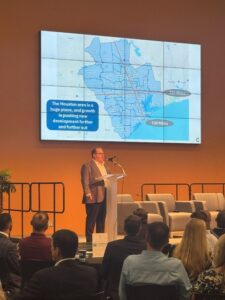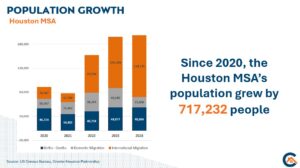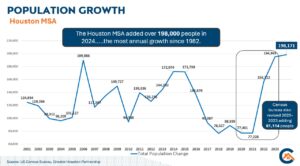
At our 2025 Quality Planned Development (QPD) Symposium, Brian Gates set the tone with a powerful introduction on the importance of not just managing growth, but shaping it intentionally. Following that, Lawrence Dean of Community Builders Advisory Services took the stage to provide an in-depth look at the drivers of population and housing growth in the Houston region—and why quality planning matters more now than ever.
 Dean began by emphasizing a simple truth: growth is inevitable. Using data from the CBAS Community Vision platform, he illustrated the sheer geographic scale and development pressure in the Houston area. Defined broadly to include Bryan–College Station and outlying counties, the region spans 121 miles east to west and 139 miles north to south—larger than many U.S. states. Across this vast area, the demand for housing and infrastructure continues to grow rapidly.
Dean began by emphasizing a simple truth: growth is inevitable. Using data from the CBAS Community Vision platform, he illustrated the sheer geographic scale and development pressure in the Houston area. Defined broadly to include Bryan–College Station and outlying counties, the region spans 121 miles east to west and 139 miles north to south—larger than many U.S. states. Across this vast area, the demand for housing and infrastructure continues to grow rapidly.
In just the most recent 12-month period tracked by the U.S. Census Bureau, the Houston metro area added 198,000 people, making it the second-fastest-growing metro in the nation, behind only New York City. Since 2020, that total climbs to 717,000 new residents—more than the entire population of many standalone cities in other parts of the country.
Breaking down this growth, Dean noted that the largest share has come from international migration, followed by natural population growth (births minus deaths), and finally domestic migration from other parts of Texas and the U.S. Every Houston-area county saw more growth from migration than from natural increase. In particular, Fort Bend and Harris counties saw the most international migration, while Liberty County, often considered on the fringe of the metro, posted the highest percentage growth, topping 5% in the last year.

This rapid population increase has a direct impact on housing and development. Houston added nearly 50,000 jobs in the 12 months ending March 2025, continuing a post-COVID trajectory of strong employment recovery and expansion. Since the onset of the pandemic, the region has added nearly 295,000 jobs, driving even greater demand for housing.
That housing demand is reflected in construction data: in the year ending Q1 2025, Houston saw nearly 41,000 housing starts and over 41,000 closings, with annual starts up 4% and closings up nearly 9%. Despite expectations for a moderate slowdown later in the year, these levels remain well above long-term averages.
Houston also leads the nation in single-family building permits, with over 50,000 issued in 2024 alone, putting it ahead of Dallas–Fort Worth and every other major metro. However, Dean pointed out a clear trend: Harris County’s share of new single-family permits has declined, dropping from 67% in 2003 to just 38% today. This reflects the reality that much of the county’s developable land has already been built out.
As a result, growth is now shifting outward, particularly to Waller and Liberty counties, where development activity is accelerating rapidly. These areas are seeing the highest percentage increases in permit volume and are expected to play a central role in regional growth over the next decade.
 Looking ahead, projections from the Texas Demographic Center estimate that the Houston region will add between 320,000 and 680,000 people by 2030. Even the lower end of that range presents major implications for infrastructure, housing, and public services. The upper end—another 680,000 people—represents the equivalent of an entire mid-size U.S. city relocating to the region within just a few years.
Looking ahead, projections from the Texas Demographic Center estimate that the Houston region will add between 320,000 and 680,000 people by 2030. Even the lower end of that range presents major implications for infrastructure, housing, and public services. The upper end—another 680,000 people—represents the equivalent of an entire mid-size U.S. city relocating to the region within just a few years.
Dean closed by reiterating that this tremendous growth presents not just challenges, but opportunities for intentional, high-quality development. As the region expands, it is up to leaders, planners, developers, and public officials to ensure that what is built today continues to serve communities for decades to come.
